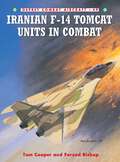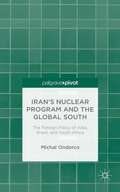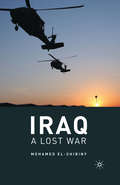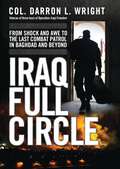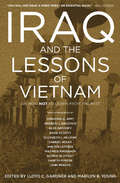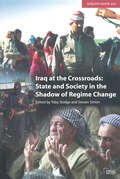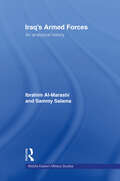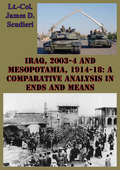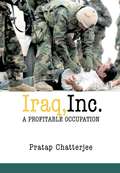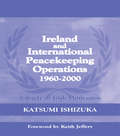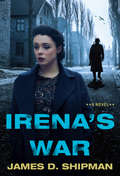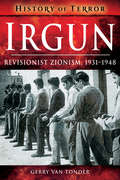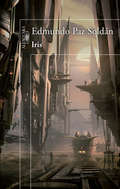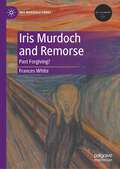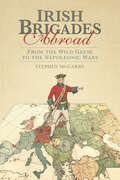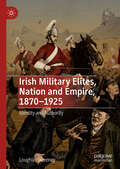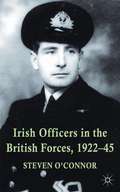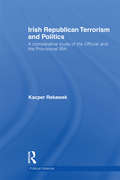- Table View
- List View
Irandam Ulagappor
by Pa. RaghavanA summary of events that led to the Second World War, the war that shook the entire world and the devastations it caused to the mankind, the role of Hitler in sustaining the war is well written and presents a fair protrayal in this book.
Iranian F-14 Tomcat Units in Combat
by Chris Davey Tom CooperSo formidable an opponent did the Iraqi airforce consider the F-14 that during the Iran-Iraq War (1980-1988), they ordered their pilots not to engage F-14s and the presence of one in an area was usually enough to empty it of Iraqi aircraft. Officially losses where tiny; only one F-14 was lost in aerial combat (to a MiG-21), one to a control problem and one downed by a ground-to-air missile. This book looks at the F-14's Iranian combat history and includes first hand accounts from the pilots themselves. It will consider key engagements and the central figures involved, illustrating the realities, successes and failures of the Iranian air campaign.
Iranian F-4 Phantom II Units in Combat
by Jim Laurier Farzad BishopDifferent versions of the jet have provided the backbone of the frontline strength of the Iranian air force since the 1970s, and whole generations of Iranian pilots and ground personnel have been trained to fly and maintain them. Indeed, the type bore the brunt of active combat operations during the long war with Iraq. Iranian F-4 Phantom IIs were also some of best equipped examples ever exported by the USA. Some Iranian Phantom II pilots gathered immense experience on the type, flying it in combat for more than ten years. This book removes the veil of secrecy surrounding Iranian Phantom II operations since the Iran-Iraq War (1980-1988).
Iran’s Military Power Projection and the Empowerment of Ansar Allah (Non-State Actors in International Relations)
by Fatima MoussaouiThe Islamic Republic of Iran, although it has become famous for its foreign policy choices and actions on the international scene, it remains an enigma for the West. This book provides an introspective analysis of the foundation of this unique Islamic state, and reveal what makes it resilient, and attempts to sustain it. Taking a multidisciplinary approach using anthropological, philosophical, psychological, and military grids, the book revisits the power of the clergy and maps out its original meaning and its ability to be wielded to serve policies in line with Iran's contemporary political context. This book will be of interest to students and scholars of military strategy, international security, and geostrategy, as well as military officers and policy makers who will benefit from the fresh perspective it adds to the Western view of a country whose strategic and military thinking is still largely unknown or misunderstood.
Iran’s Nuclear Program and the Global South: The Foreign Policy Of India, Brazil, And South Africa
by Michal OndercoThis book studies the reactions of India, Brazil, and South Africa the three main non-proliferation actors of the Global South to Iran's nuclear program. Their responses are explained and situated in wider foreign policy context.
Iraq
by Mohamed El-ShibinyIraq: A Lost War deals with the impact of September 11th on the occupation of Iraq and the U. S. declaration of war on international terrorism. It investigates whether war in Iraq was morally justified and whether coalition forces capturing and hanging its president were morally and legally acceptable internationally.
Iraq Full Circle
by Darron WrightCol. Wright served three tours of duty in the Iraq War, commanding the last active combat brigade to withdraw from Operation Iraqi Freedom. His book personalizes the broader operational conflict we've all heard so much about, giving us a previously unknown insider command perspective that will fundamentally change how our nation thinks of the war. For Col Wright, the Iraq war was a good war fought well. In his new book, Iraq Full Circle, he offers a first-hand assessment of the US Army's eight year war in Iraq.As battalion operations officer for an infantry battalion from 2003-2004 operating in the dangerous and volatile Sunni Triangle, followed by a tour of duty as a Brigade Executive Officer from 2005-2006 in Baghdad, Wright witnessed some of the harshest fighting seen during the war. He saw the evolution from 'shock and awe' to the 'clear-hold-build' strategy during the height of sectarian violence and was on-hand for the transition to COIN followed by the handover of security operations to the Iraqi Security Forces. In August 2010, Wright, as a deputy brigade commander, was among the last combat soldiers to leave Iraq as part of President Obama's draw-down of troops.While Wright does not hesitate to criticize the political and military leadership that failed to foresee the insurgency, or the errors in judgment that led to the dismantling of the Iraqi Army in 2003, his overall assessment of the war is that the US Army achieved what it was asked to do by two Presidents. Calling upon his experience--and the examination of thousands of after action reports, combat operations orders, and over 100 interviews--Wright pieces together a compelling and cohesive narrative of the war. Readers will be surprised to learn:· Wright had a strong hunch beginning in September 2001 that he would be deployed to Iraq; he and his fellow Army leaders began preparing for an invasion soon after the 9/11 attacks.· Army leaders were already implementing much of the COIN doctrine in 2004 and 2005, well before the official change in doctrine and the publication of the new field manual on COIN.· For Wright and most other leaders at his level, President Bush's troop "surge" in November 2006 was completely uncontroversial and utterly inevitable. They knew that clear-hold-build was the right strategy and would work but that they did not have enough troops to make it stick.In his closing chapters, Wright discusses the growth and evolution of the Iraqi Security Forces, from an abjectly corrupt and militarily useless cohort in 2004 to a well-trained and stable entity capable of securing Iraq and providing for (mostly) safe and open national elections in 2010. He finishes his narrative with his thoughts on the future of Iraq, understanding that sectarian divisions persist, but that the Iraqi Security Forces have been well-trained by the US Army to secure Iraq's future.From the Hardcover edition.
Iraq and the Lessons of Vietnam: Or, How Not to Learn from the Past
by John Prados Andrew J. Bacevich Christian G. Appy David Elliott Gabriel Kolko Alex Danchev Wilfried Mausbach Walter LaFeber Alfred W. McCoy Gareth Porter Elizabeth L. HillmanEssays by Christian G. Appy, Andrew J. Bacevich, John Prados, and others offer &“history at its best, meaning, at its most useful.&” —Howard Zinn From the launch of the &“Shock and Awe&” invasion in March 2003 through President George W. Bush&’s declaration of &“Mission Accomplished&” two months later, the war in Iraq was meant to demonstrate definitively that the United States had learned the lessons of Vietnam. This new book makes clear that something closer to the opposite is true—that US foreign policy makers have learned little from the past, even as they have been obsessed with the &“Vietnam Syndrome.&” Iraq and the Lessons of Vietnam brings together the country&’s leading historians of the Vietnam experience. Examining the profound changes that have occurred in the country and the military since the Vietnam War, this book assembles a distinguished group to consider how America found itself once again in the midst of a quagmire—and the continuing debate about the purpose and exercise of American power. Also includes contributions from: Alex Danchev * David Elliott * Elizabeth L. Hillman * Gabriel Kolko * Walter LaFeber * Wilfried Mausbach * Alfred W. McCoy * Gareth Porter &“Essential.&” —Bill Moyers
Iraq at the Crossroads: State and Society in the Shadow of Regime Change (Adelphi series #354)
by Steven Simon Toby DodgeA war against Iraq will spur radical changes in the way the country is governed, how its people live, and its relationship to its neighbours and to the West. This book depicts the evolution of Iraq under Saddam Hussein, and describes each side's battle plan and the war's likely aftermath.
Iraq's Armed Forces: An Analytical History (Middle Eastern Military Studies)
by Ibrahim Al-Marashi Sammy SalamaThis book provides the first comprehensive study of the evolution of the Iraqi military from the British mandate era to post-Baathist Iraq. Ethnic and sectarian turmoil is endemic to Iraq, and its armed forces have been intertwined with its political affairs since their creation. This study illustrates how the relationship between the military and
Iraq, 2003-4 And Mesopotamia, 1914-18: A Comparative Analysis In Ends And Means
by Lieutenant Colonel James D. ScudieriThis paper is a comparative analysis of the British campaign in Mesopotamia during the First World War, 1914-18 and the current campaign in Iraq, 2003-4. The study focuses on an examination of Phase III decisive operations and Phase IV reconstruction operations, including strategic imperatives, operational planning, and the impact of changes during operations. The British had no campaign plan for Mesopotamia upon the outbreak of war in 1914. Deployment to this theater began as a peripheral operation. Overriding politico-strategic requirements spurred further exploitation to reach Baghdad. Failure to match ends and means resulted in the disastrous surrender of a division at Kut on 29 April 1916. Sweeping reorganization and large-scale reinforcements resumed the advance; Baghdad fell on 11 March 1917. The British conducted ad-hoc reconstruction operations throughout this period, beginning in the Basra vilayet and expanding their scope with the capture of Baghdad. The British established viable civil institutions, to include police forces, a functioning legal system, Revenue and Customs Departments, a banking system, and even domestic mail.Conversely, the recent U.S. strategy of pre-emption in Iraq was a policy decision based upon the wider strategic perspective and benefited from exhaustive operational planning. However, the rolling start campaign utilized minimal forces. They had the capability to win the decisive operations phase rapidly, but this same troop level was woefully inadequate to conduct incompletely-planned, sorely under-estimated, post-conflict operations. Both campaigns suffered from a serious mismatch of ends and means at certain stages, especially for post-war reconstruction operations. They achieved significant success due to herculean efforts in theater. The study concludes with recommendations for strategic leaders related to planning and force structure.
Iraq, Inc.: A Profitable Occupation (Open Media Series)
by Pratap ChatterjeeMore than one year after the "fall of Baghdad," the reconstruction of Iraq was failing terribly. Ordinary Iraqis waited in line for basic necessities like clean water and fuel, while the number of civilians and soldiers killed escalated in tandem with the billions of U.S. tax dollars spent. In Iraq, Inc.: A Profitable Occupation, Pratap Chatterjee delivers an on-the-ground account of the occupation business, exposing private contractors as the only winners in this war.Chatterjee examines the big failings and even bigger swindles of Iraq's corporate managers, from the dangerous follies of an out-of-touch government-in-exile to the unchecked price gouging by Cheney's successors at Halliburton. In Iraq, Inc. Chatterjee contrasts the employment boom of mercenaries--more than 20,000 soldiers of fortune from apartheid-era South Africa, Pinochet's Chile, and elsewhere in Iraq--with the crowds of unemployed locals ripe for recruitment to the resistance.Drawing on years of research and first-hand experience in the region including his live reporting from post-invasion Iraq as he traveled around the country first in December 2003 when Saddam Hussein was captured and in April 2004 during the height of the siege of Fallujah, Chatterjee brings us the dilapidated hospitals, looted ministries, and guarded corporate enclaves that mark the plunderous road to America's free Iraq.
Iraq, Lies, Cover-ups, & Consequences
by Rodney Stichauthor alleges corruption and lies by all three branches of US government support Iraq war after September 11.
Iraq: Threat and Response
by Gerhard BeestermoellerThis volume of essays about the ongoing crisis concerning Iraq is written from the perspective of the "thoughtful opposition." German and American scholars from diverse backgrounds--moral theology, policy analysis, political science, Middle Eastern history--all criticize, albeit sometimes for different reasons, unilateral U.S. military action against Iraq.The chapters are uniformly free of intemperate language and careless argumentation characteristic of much opposition to American foreign policy. The authors address the moral, legal, political, or historical dimensions of the Iraq problem. They also assess the threat Saddam Hussein represents to his region and the world as well as the prospects for alternative strategies. The reasoning is well-informed, sensitive to complexity, and attentive to detail.Contributions include: Klaus Dicke, "Peace Through International Law and the Case of Iraq"; Hans J. Giessmann, "The Dubious Legitimacy of Preventive Military Action against Iraq"; John Langan, "Is Attacking Iraq a Good Idea?" and "Is There a Just Cause for War against Iraq?"; Gerhard Beestermller, "The United States: Legitimate Authority for War against Iraq?"; Drew Christiansen, "Holy See Policy towards Iraq"; Henner Frtig, "Iraq: How Severe is the Threat?"; and David Cortright, Alistair Millar, and George A. Lopez, "Sanctions, Inspections and Containment. Viable Policy Options in Iraq."While Iraq: Threat and Response may not be welcomed by uncritical supporters of U.S. policy, it is a reasoned, compassionate exploration of alternatives to military action in Iraq. The volume is clearly designed to strengthen opposition to unilateral action in the United States and abroad. It will be of great interest to students of foreign policy, military studies, and the Middle East.Gerhard Beestermller is deputy director of the Catholic Institute for Theology and Peace, near Hamburg. His focus of research is political ethics and peace ethics. David Little is T.J. Dermot Dunphy Professor of the Practice in Religion, Ethnicity, and International Conflict and director of Initiatives in Religion and Public Life at Harvard Divinity School. He is the author, with Scott W. Hibbard, of Islamic Activism and U.S. Foreign Policy.
Iraqigirl: Diary of a Teenage Girl in Iraq
by Elizabeth Wrigley-FieldHadiya began her blog just under a year and a half into the U.S. occupation of Iraq. She writes from Mosul, a diverse city with many Sunni Muslims, like Hadiya's family. Mosul has become one center of resistance to the occupation. Hadiya's name is not really Hadiya. We have used pseudonyms for every Iraqi in this story because each of their lives could be in danger if they were identified. But Hadiya is a real teenager in Mosul, and this is her story.
Iraq’s Sunni Insurgency: Iraq's Sunni Insurgency (Adelphi series)
by Ahmed S. HashimFrom 2003 to 2008, the Sunni Arab insurgency in Iraq posed a key challenge to political stability in the country and to Coalition objectives there. This paper explains the onset, composition and evolution of this insurgency. It begins by addressing both its immediate and deeper sociopolitical origins, and goes on to examine the multiple ideological strands within the insurgency and their often conflicting methods and goals. Despite organisational incoherence due to the existence of a large number of competing groups, the insurgency in Iraq sustained a particularly high tempo of operations between 2004 and 2006, causing considerable military and civilian casualties. Some insurgent groups focused on attempting to foment civil war between two of Iraq’s major communities, the Sunni and Shia Arabs and, by late 2006, they had come close to unravelling Iraq and presenting the Coalition with a major defeat. The adoption of a new approach by the US in 2007 helped reduce the level of violence in Iraq. In addition, deep fissures within the insurgency itself, between those fighting for more practical, immediate goals and the transnational Islamists and their local allies fighting for wider-reaching goals – including the promotion of sectarian strife – contributed to the insurgency’s diminution. It remains to be seen whether there will be a widespread recognition among Sunni Iraqis of the need to work with the Coalition to facilitate their community’s reintegration into the new Iraqi body politic.
Ireland and International Peacekeeping Operations 1960-2000
by Katsumi IshizukaThe Republic of Ireland has won its status as a leading contributor to international peacekeeping operations, which has been its key 'foreign policy' since the 1960s. But why is Ireland so keen to be involved? This new book asks and answers this and other key questions about Ireland's close involvement with the EU. It cannot simply be for charitable reasons, so is it because it is a neutral state or because it is a middle power? Overall, is Ireland's peacekeeping policy based on realism and liberalism? The characteristics of peacekeeping operations have changed significantly, especially since the end of the Cold War. Can Ireland survive as a traditional peacekeeping contributor or does it have to change its peacekeeping policy radically? And will it be able to maintain its distance from NATO and the EU in terms of peacekeeping operations? This title attempts to answer all of these questions, drawing on a wide range of resources from literature, Irish and UN documents, to newspapers and interviews.
Irena's War
by James D. Shipman&“Shipman dazzles in this historical tour-de-force based on the real-life story of WWII Polish resistance fighter Irena Sendler . . . spellbinding." —Publishers Weekly (Starred Review)Based on the gripping true story of an unlikely Polish resistance fighter who helped save thousands of Jewish children from the Warsaw ghetto during World War II, bestselling author James D. Shipman&’s Irena&’s War is a heart-pounding novel of courage in action, helmed by an extraordinary and unforgettable protagonist. September 1939: The conquering Nazis swarm through Warsaw as social worker Irena Sendler watches in dread from her apartment window. Already, the city&’s poor go hungry. Irena wonders how she will continue to deliver food and supplies to those who need it most, including the forbidden Jews. The answer comes unexpectedly. Dragged from her home in the night, Irena is brought before a Gestapo agent, Klaus Rein, who offers her a position running the city&’s soup kitchens, all to maintain the illusion of order. Though loath to be working under the Germans, Irena learns there are ways to defy her new employer—including forging documents so that Jewish families receive food intended for Aryans. As Irena grows bolder, her interactions with Klaus become more fraught and perilous. Klaus is unable to prove his suspicions against Irena—yet. But once Warsaw&’s half-million Jews are confined to the ghetto, awaiting slow starvation or the death camps, Irena realizes that providing food is no longer enough. Recruited by the underground Polish resistance organization Zegota, she carries out an audacious scheme to rescue Jewish children. One by one, they are smuggled out in baskets and garbage carts, or led through dank sewers to safety—every success raising Klaus&’s ire. Determined to quell the uprising, he draws Irena into a cat-and-mouse game that will test her in every way—and where the slightest misstep could mean not just her own death, but the slaughter of those innocents she is so desperate to save.
Irgun: Revisionist Zionism, 1931–1948 (History of Terror)
by Gerry van TonderA history of the controversial underground group that employed political violence in its quest to create an independent Israel. Includes photos. In October 1944, the US Office of Strategic Services described the Irgun Tsvai Leumi—National Military Organization—as &“an underground, quasi-military organization with headquarters in Palestine . . . fanatical Zionists who wish to convert Palestine and Transjordan into an independent Jewish state [and] advocate the use of force both against the Arabs and the British to achieve this maximal political goal.&” This book delves into the origins and history of Irgun. In 1925, Ze&’ev Jabotinsky founded the Revisionist Zionism organization, whose secular, right-wing ideology would lead to the formation of the Irgun and, ultimately, of the Likud Party. Commencing operations in the British Mandate of Palestine in 1931, Irgun adopted a mainly guarding role, while facilitating the ongoing immigration of Jews into Palestine. In 1936, Irgun guerrillas started attacking Arab targets. The British White Paper of 1939 rejected the establishment of a Jewish nation, and as a direct consequence, Irgun guerrillas started targeting the British. The authorities executed captured Irgun operatives found guilty of terrorism, while deporting hundreds to internment camps overseas. As details of Jewish genocide—the Holocaust—emerged, Irgun declared war on the British in Palestine. Acts of infrastructural sabotage gave way to the bombing of buildings and police stations, the worst being the bombing of the King David Hotel in Jerusalem—the hub of British operations and administration—in July 1946, killing ninety-one. Freedom fighters or terrorists, Irgun was only dissolved when the independent Jewish state of Israel was born on May 14, 1948. This is their story.
Iris
by Edmundo Paz SoldánUna distopía arrolladora e hipnótica sobre la forma en que se reinventan los individuos en tiempos de guerra, una fábula desoladora sobre los excesos del poder y, al final, un relato esperanzador sobre la lucha por la libertad. <P><P>En un futuro no muy lejano, en una región tóxica llamada Iris, se encuentra el Perímetro, territorio de las fuerzas colonizadoras. En el Perímetro viven Xavier, un soldado que debe lidiar con una traumática herida de combate, y el capitán Reynolds y su unidad, que, cansados ante las victorias de los irisinos liderados por Orlewen, deciden emprender su guerra particular. <P><P>El Perímetro es también el hogar de Yaz, una enfermera que se encuentra allí en busca del jün, planta sagrada que ofrece visiones psicotrópicas y trascendencia. Pero el combate no solo se libra en la capital. La lucha se traslada a Malhado, un valle florido donde -cuentan las leyendas irisinas- vive el temible Malacosa, y a Megara, centro dela explotación minera y de los mitos en torno a Xlött, el dios demoníaco en nombre del cual se inicia la batalla final por la independencia de Iris. <P><P>Iris es una novela de gran originalidad, un paso adelante en la trayectoria de Edmundo Paz Soldán. Desde la primera página, transporta a los lectores a un mundo tenebroso y los somete a su lógica, a su delirio, a su violencia y angustia.
Iris Murdoch and Remorse: Past Forgiving? (Iris Murdoch Today)
by Frances WhiteThis exploration of the crucially important role played by remorse in Iris Murdoch’s philosophical, theological, and political thinking identifies it as a critical concept in her moral psychology and a recurrent theme in her art. Through engagement with Simone Weil, current theories of remorse, trauma theory and Holocaust studies, it offers fresh perspectives on Murdoch’s fiction – particularly the late novels, her radio play The One Alone, and her monograph Heidegger.
Irish Brigades Abroad: From the Wild Geese to the Napoleonic Wars
by Stephen McGarryIrish Brigades Abroad examines the complete history of the Irish regiments in France, Spain, Austria and beyond. Covering the period from King James II’s reign of the three kingdoms of England, Scotland and Ireland in 1685, until the disbandment of the Irish Brigades in France and Spain, this book looks at the origins, formation, recruitment and the exploits of the Irish regiments, including their long years of campaigning from the War of the Grand Alliance in 1688 right through to the Napoleonic Wars in 1815. What emerges is a picture of the old-fashioned virtues of honour, chivalry, integrity and loyalty, of adventure and sacrifice in the name of a greater cause.
Irish Military Elites, Nation and Empire, 1870–1925: Identity and Authority
by Loughlin SweeneyThis book is a social history of Irish officers in the British army in the final half-century of Crown rule in Ireland. Drawing on the accounts of hundreds of officers, it charts the role of military elites in Irish society, and the building tensions between their dual identities as imperial officers and Irishmen, through land agitation, the home rule struggle, the First World War, the War of Independence, and the partition of Ireland. What emerges is an account of the deeply interwoven connections between Ireland and the British army, casting officers as social elites who played a pivotal role in Irish society, and examining the curious continuities of this connection even when officers’ moral authority was shattered by war, revolution, independence, and a divided nation.
Irish Officers in the British Forces, 1922–45
by Steven O’ConnorIrish Officers in the British forces, 1922-45 looks at the reasons why young Irish people took the king's commission, including the family tradition, the school influence and the employment motive. It explores their subsequent experiences in the forces and the responses in independent Ireland to the continuation of this British military connection.
Irish Republican Terrorism and Politics: A Comparative Study of the Official and the Provisional IRA (Political Violence)
by Kacper RekawekThis book examines the post-ceasefire evolutions and histories of the main Irish republican terrorist factions, and the interconnected character of politics and militarism within them. Offering the first comparative study of the two leading Irish republican terrorist movements the Official IRA and the Provisional IRA (PIRA), this book presents the lesser-known Officials’ political-military evolution and analyses whether they could have been role models for the Provisionals. Not only does it compare the terrorism and the politics of the Officials and Provisionals in the aftermath of their seminal ceasefires of 1972 and 1994, it also presents the Irish republican history in a new light and brings to the fore the understudied and disregarded Officials who called their seminal ceasefire twenty-two years before their rivals in 1972. In doing this, the work discusses whether the PIRA might have learned lessons from the bitter and ultimately unsuccessful experience of the Officials. This book goes beyond traditional interpretations of the rivalry and competition between the two factions with the Officials usually seen as non-violent but unsuccessful and the Provisionals less politically inclined and mostly concerned with their armed struggle. Simultaneously, it dispels the myth of the alleged Provisional republican copying of their Official republican counterparts who seemed ready for a political compromise in Northern Ireland more than twenty years before the Good Friday Agreement of 1998. Finally, it comprehensively compares the Officials and the Provisionals within the identified key areas and assesses the two factions’ differences and similarities. . This book will be of much interest to students of Irish politics, terrorism studies, security studies and politics in general.

